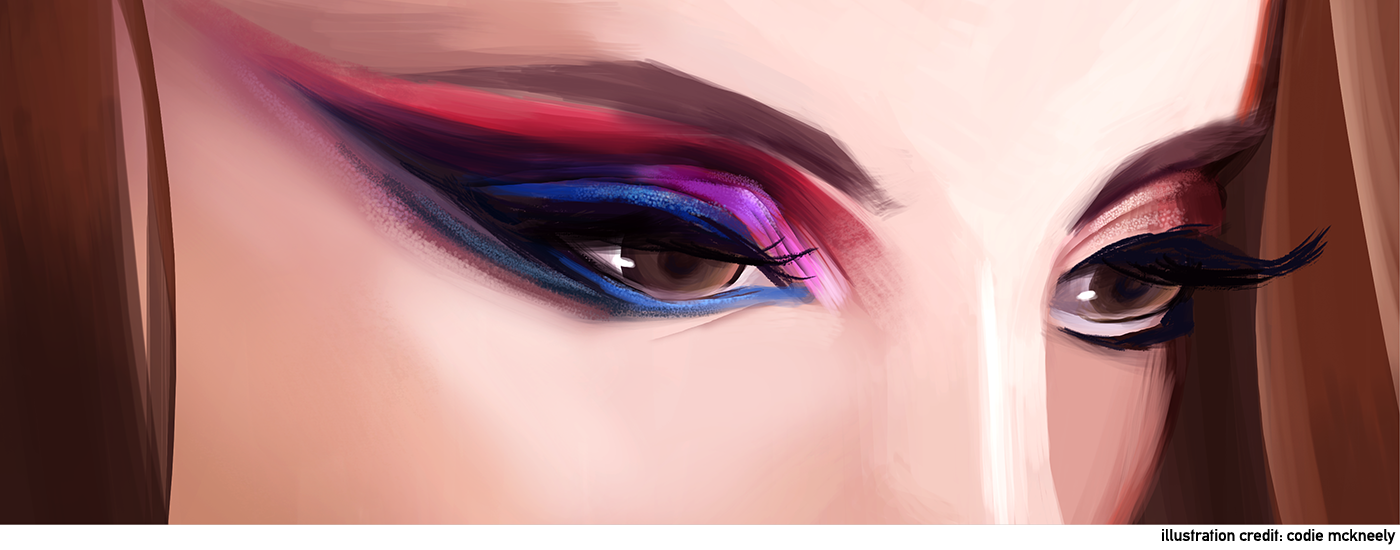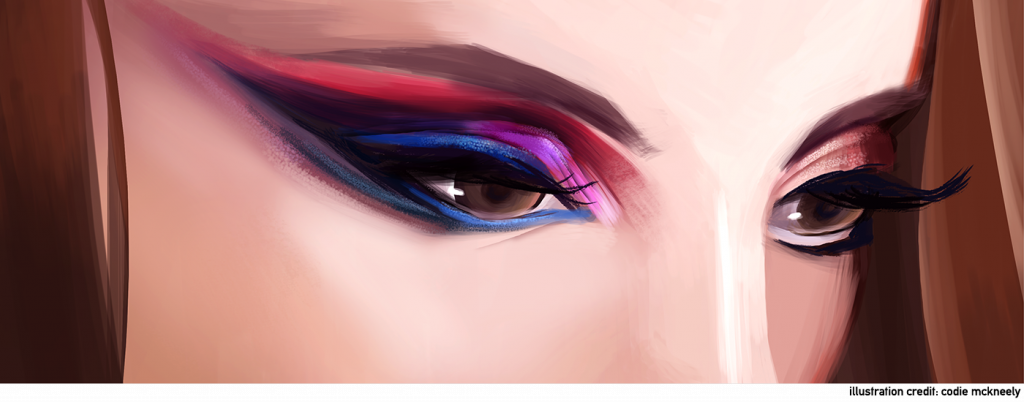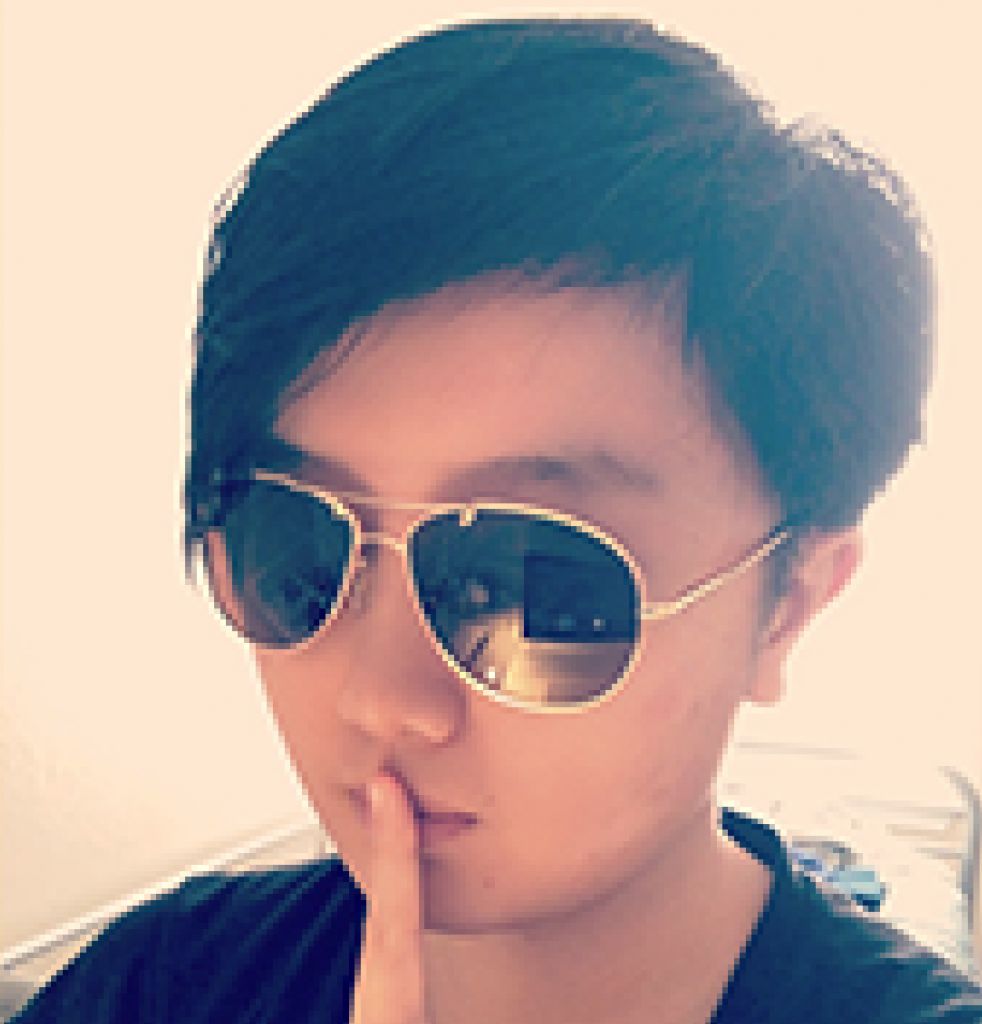

Art comes in a variety of media, from traditional paint on canvas to sand mandalas, the traditional Tibetan practice of constructing temporary art from sand. All art mediums also come with a wide variety of political implications — Street art such as works done by Banksy and more traditionalist pieces such as Frida Kahlo all use art as a means of expressing their political views — be it commentary on classism or critiques on Euro-centric beauty standards. Just like any art medium, there’s political implications also regarding the intentions and the implications of cosmetics. However, these examples of activism through traditional art all share a common theme: revolting against oppressive systems and/or ideology, which facial cosmetics fail to do. It is rarely ever used as a means of protesting misogyny- the oppressive ideology that propels how it is marketed in the first place. Instead, makeup mostly serves to uphold certain conventional European-centric standards, and it is this aspect of makeup that the online beauty community finds it hard to address whenever these concerns are brought up.
The beauty community often claims that makeup is an exclusively empowering medium in which the canvases are the makeup artists’ faces. While no one can deny that facial cosmetics certainly can be empowering on an individual basis, it would be naive to deny that the conventional beauty standards that developed alongside makeup restrict it from upholding anything but the status quo. In fact, there was a video trending on Twitter in which a user questions just how similar makeup is to art. She points out that if makeup is completely free from its Eurocentric beauty expectations, therefore allowing artists to express whatever they please, then how come it’s almost never used by said artists to protest those conventional expectations?
The online beauty community responded by berating the user’s appearance and claiming that the ‘real’ reason she’s criticizing cosmetics is because of her lack of skill when it comes to using them. It is evident that bringing up the misogynistic expectations that still haunt makeup sparks a lot of controversy. However, this controversy in particular proves that the beauty community isn’t addressing the problems that surround their medium and instead elects to ignore it and antagonize those who raise these concerns.
No problem gets solved by running away from it. This is why there needs to be an open dialogue between makeup enthusiasts and professional makeup artists about cosmetics’ long history with misogyny and how that history still affects them today.
Profitable Activism
In Wendy Chapkis’ Beauty Secrets, she references a Removatron Hair Removal ad from 1986 America in which a child asks her mother why she has a faint mustache. The mother responds by stating that sometimes “even nature makes mistakes.” This statement suggests that there is something inherently wrong with how a woman’s body is and how one can “fix” such a mistake with enough money. In that same chapter, Chapkis also points out how hair removal is one of the fastest-growing beauty industries of her time, and that is estimated that 85-90 percent of all women have unwanted facial/body hair. It seems that cosmetic companies are more than happy to maintain or even drive up such a statistic for the sake of more profits.
It is no secret that large corporations have a long history when it comes to promoting Eurocentric colonial beauty expectations. It is the same standards that declare pubic hair on women as “nature’s mistake” as seen in the Removatron ad referenced above. Corporations are notorious for shaming women into buying their products. For the longest time, their message was “If you want to be beautiful, then you need to buy these products.” Nowadays, that practice is seen as harmful and outdated, but cosmetic companies still consistently strive to make their customers desire their products. While the marketing for those products has changed, their overall message to consumers hasn’t.
A 2016 article in the Journal of Experimental Psychology titled Human Perception and Performance highlighted how women who wear makeup are perceived by men and women. Surprisingly, neither demographic saw women who wear makeup as more attractive as opposed to women without facial cosmetics. Instead, men perceive women with makeup to be more prestigious whereas women perceive women with makeup to be more dominant. This perception is likely influenced by how cosmetic companies market their products to their current consumers. Instead of pushing women to be more dainty and submissive, today’s makeup marketing pushes women to take up space and have more of a presence.
In today’s cosmetic world, advertisers such as Olay and Covergirl push the women empowerment narrative in order to sell their products. Olay released a commercial titled Your Best Beautiful which features various accounts by Thai women highlighting how they’re not allowed to wear a lot of makeup in their work setting. The cosmetic company addressed the issue of women not being able to express themselves through makeup by holding a beauty contest. In 2014, Covergirl released a commercial titled #GirlsCan that features a variety of female celebrities which very explicitly focused its message on women’s empowerment. The advertisment essentially plays out like a feminist campaign video that only remembers that it’s a Covergirl commerical at the very end. One might wonder why this should be considered a bad thing in the first place. After all, if advertisers are telling women to be more dominant and prestigious, shouldn’t that be encouraged? However, the problem with more modern cosmetic advertising is the same underlying problem found in older makeup advertising: it places too much of the woman’s value in her appearance.
Successful corporations evolve with their target audience, and cosmetic companies are not different. The vast majority of the women being marketed to are part of the labor force. Anyone who knows the very basics of social politics will know that women are generally not treated as equals by their male co-workers. Men have a history of undervaluing women in the labor force,which still affects today’s social environment. A professional woman wants nothing more than to be seen as just as — if not more — qualified in comparison to her colleagues. Cosmetic companies realize this, and therefore target this insecurity found in many women.
It makes sense for a professional woman to want to be seen as prestigious and dominant, for that is part of how they elevate themselves up their career ladders. In Lu Junqing’s Beautiful Faces Grow on Rice, Junqing points out that a woman’s career success is often determined by just how willing she is to commit to modern beauty standards. Additionally, Junqing points out that plenty of women will flock to retail beauty counters to talk to cosmetic consultants about enhancing their appearance in order to secure a place in the labor force.
Dr. Tara Well, a professor of psychology at Barnard College of Columbia University is not surprised by such a phenomenon. She states that when a woman wears make-up, it is implied that she takes good care of herself and therefore will do a good job in taking care of other people and various projects. In other words, women who wear makeup are more likely to be accepted into management positions.
With all that being said, it is evident that cosmetic corporations don’t actually empower anyone. All they did was create a new standard to restrict women, all for the sake of profit. While this type of marketing can no doubt make some women feel empowered, the truth of the matter is that it just contributes to these new types of sexist expectations surrounding makeup. These expectations pressure those affected by misogyny to wear makeup in order to be taken seriously. It is a type of profitable activism that is found everywhere from the cosmetic commercial on TV to the sponsored beauty-vlogger youtuber with thousands of subscribers. The targeted consumers are given the illusion of choice that conveniently results in all of them abiding by the same standards of beauty that continuously feeds on their insecurities.
Make-up is Art
There are many who are quick to defend makeup as something that is purely art and dismiss any criticisms regarding its association with conventional and restrictive beauty standards. As mentioned before, no one can deny that makeup certainly can be art, but it is at least a little hypocritical to claim to be an empowered feminist and then turn around and berate other women for their appearence because they question the standards associated with makeup.
If makeup truly has no misogynistic expectations related to it and therefore really is nothing more than an art medium, then why is there so much shame that comes with not doing it or doing too much of it? It is rare to see someone being shamed for not making art or making too much art but you will often see someone shamed for not wearing makeup or wearing too much makeup. Moreover, it is especially rare to feel pressured by society to make art just so they can find you to be more desirable as a person. If makeup truly has no problems and is just another art medium, then why is it that most people who do makeup want to create the same 3-4 looks over and over again based on whatever trend is in style at the time? Art is often used as an outlet for artists to express themselves. They use art to express the unique aspects of themselves in a way that is meaningful to them. If that’s the case, then why do thousands of people express themselves through the same 3-4 looks every time they apply makeup? Are millions of people really that similar in terms of experience to the point they all produce the same sets of art pieces over and over again? If millions of people were painting the same 3-4 paintings over and over again we would consider that to be extremely unusual but that’s not the case when it comes to makeup. It’s almost as if there is a certain set of standards those who wear makeup are following in order to be considered at the very least acceptable.
One might argue that makeup, like any art medium, has a set of artistic fundamentals it must follow and those fundamentals are the standards as mentioned before. The purpose behind art fundamentals is to better the technicalities of the composition itself. While one can argue that makeup’s fundamentals can also be used to better the technicalities of one’s facial composition, that assertion doesn’t hold up whenever addressing “natural” makeup looks. There is a crucial difference between utilizing color theory when applying bright blue streaks across your face and spending hours upon hours to look “natural” through the use of makeup. Who or what defines what is natural? If natural is defined as something created by nature, then why does the “natural” look involve covering up all the creases and the acne on your face? If natural is defined as something created by nature, then why does such a “natural” look involve contouring and distorting one’s cheek structure to the point of exaggeration? It is crucial to question why some things are considered to be “natural” and others not so “natural,” for it is very likely that the same Eurocentric beauty expectations we abide by today were the same standards that declared hair on a woman’s face “nature’s mistake.”
To reference Wendy Chapkis again, she states that the relationship women have with societal beauty expectations has reduced them to be “foreigners attempting to assimilate into a hostile culture” while our bodies “continually threaten to betray their difference.” The marketing of facial cosmetics has led women to perceive their “undisguised self (as) unacceptable” which is a rather strange phenomenon caused by something that is exclusively an artform. According to a 2013 study released by the University of Wisconsin La Crosse, 44% of American women feel uncomfortable leaving the house without any makeup on no matter where they’re going. In that same study, it concluded the psychological factors that lead to increased cosmetic uses include anxiety, self-consciousness, and conformity.
One could counter this by stating that these misogynistic attributes of makeup are a thing of the past, and women should move forward by reclaiming makeup as something that liberates them. While women should absolutely reclaim makeup, what isn’t part of reclamation is dismissing the oppressive attributes that still remain. A group of activists intending for something harmful to remain in the past doesn’t mean the remnants of that oppressive past is suddenly erased from current society. It is crucial to address how misogyny is still attributed with makeup in order to effectively combat it; and one of the least effective ways to combat it is to berate every person who dares criticizes its oppressive attributes.
Conclusion
Make-up certainly has the potential to be nothing more than an art medium that knows no bounds and be free from its restrictive past. However, in order to truly free makeup from that past, there needs to be an open dialogue between everyone from casual makeup users to professional makeup artists addressing its history of misogynistic beauty standards and how that history affects us in the present. It is a conversation many people ought to have without anyone taking criticisms of makeup as a personal attack.

Ellen Pu (junior | ATEC)
I am now a professional disaster artist and still a certified lesbian.
Comments